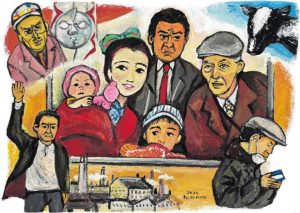Hiroshima and Film, Part 6: Kazuki Iwamoto―Director of Fukuyama Ekimae Cinema Mode
Dec. 14, 2024
“Kazoku” (‘Where Spring comes Late’; released in 1970) Director: Yoji Yamada
The movie realistically portrays the common people of the Showa period (1926-1989)
It is common knowledge for fans of the Japanese movie series “Otoko wa tsurai yo,” but there are two movies out of 50 in the series that were not directed by Yoji Yamada, although he was involved in the movies as one of the writers. They are “Otoko wa tsurai yo: Futen no Tora” (‘Tora-san, His Tender Love’), the third movie, and “Shin Otoko wa tsurai yo” (‘Tora-san’s Grand Scheme’), the fourth movie, both released in 1970. At the time, Mr. Yamada was filming the movie “Kazoku,” which was released in October of the same year. It was his long-awaited project that he had been planning for five years.
“Kazoku” begins when Seiichi Kazami (played by Hisashi Igawa), who works in a coal mine on the island of Iojima, Nagasaki Prefecture, resolves to give up his job that is in decline and move to Hokkaido, where his old friend runs a dairy farm. After deciding to rely on Seiichi’s younger brother Tsutomu (played by Gin Maeda), who works for a large ironworks in Fukuyama, Hiroshima Prefecture, to take care of their father Genzo (played by Chishu Ryu) who lives with the family, he leaves the island with his wife Tamiko (played by Chieko Baisho), three-year-old son and one-year-old daughter.
They thought Tsutomu must have a good life because he has a job that rides the wave of the times and owns a private car. However, the car Tsutomu drove to Fukuyama Station to pick them up is a minicar, and he lives in a cozy little house. His wife is pregnant with their second child. Tsutomu grumbles Seiichi is forcing him to look after their father without knowing his situation. Genzo listens to the argument between his sons in the next room. Seiichi and Tamiko change their plan and decide to take Genzo with them to Hokkaido.
The next day, with tears in his eyes, Tsutomu sends his father off at Fukuyama Station. This may seem contradictory, but Mr. Yamada said in an interview that, as the second son himself, he really understands Tsutomu’s feeling that he was relieved to be able to leave their father in his brother’s hands, but at the same time suffered from a guilty conscience. It is a masterful direction by Mr. Yamada, who does not simply divide the characters into good and evil, but describes them as real people who have weakness and cunning as well as kindness and conscience.
The family arrives at Osaka on the Sanyo Main Line. While waiting for the Tokaido Shinkansen, the family goesto the entrance of the Japan World Exposition, Osaka, 1970. However, they can only view the Expo from the outside as the time for the Shinkansen was approaching. I felt they represented the people who had been left out of the benefits of (Japan’s) high economic growth and were just watching it happen.
The family is then touched by the tragedy of losing their young daughter, who dies of travel fatigue, but they continue north. The grueling journey seems to symbolize the family’s past and future.
Seiichi and Tamiko are of the same generation as my parents, and their three-year-old son was born in 1967, the same year as I was born. My late father became a carpenter after graduating from junior high school and ran a building contractor’s office for as long as I can remember. Despite many difficulties, he worked with vigor until he was in his seventies and was called a “master carpenter.”
The film portrays the common people of the Showa period (1926-1989) who lived for the happiness of their families realistically, without glorifying them, and with esteem. This is an unforgettable film for me.
Kazuki Iwamoto
Born in Fukuyama, Hiroshima Prefecture, in 1967. He joined Fujimoto Kogyo (now Furec Co., Ltd.) in 1990 and has been involved in selecting films for late shows, converting movie theaters into “mini-theaters,” and planning events by inviting movie professionals. He passed the first level of the Eiga Kentei (the test measuring knowledge of film and film-related information) administered by Kinema Junposha.
Hato
Born in Otake City in 1981. Her real name is Keiko Hata. She creates a wide range of formative arts, including painting, graphic design, stop-motion animation, and theatrical art.
Information on the film
Japan / 106 min. / Shochiku, Co., Ltd.
[Story] Yoji Yamada
[Screenplay] Yoji Yamada, Akira Miyazaki
[Cinematography] Tetsuo Takaha
[Music] Masaru Sato
[Art] Kiminobu Sato
[Recording] Yukio Obi
[Sound tuning] Ryuji Matsumoto
[Lighting] Yoshio Uchida
[Editor] Iwao Ishii
[Performer] Takeshi Kinoshita, Chiaki Seo, Yasukiyo Umeno, Masako Tomiyama, Tokue Hanasawa, Kiyoshi Atsumi
****
In this series, the Chugoku Shimbun asks a movie-loving writer to choose a movie related to Hiroshima and to share highlights and memories of the selected movie. We will publish them from time to time.
(Originally published on December 14, 2024)








